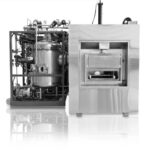As enterprises scale AI adoption, the need for robust, automated, and reliable machine learning operations (MLOps) becomes critical. Organizations are no longer experimenting with isolated models—they are operationalizing AI, deploying models in production, monitoring drift, ensuring governance, and integrating generative AI into real-world workflows. Because of this shift, businesses increasingly rely on MLOP’s Consulting Services to choose the right MLOps stack.
But with so many tools—MLflow, Kubeflow, Amazon SageMaker, Google Vertex AI, and Databricks—the question arises:
Which MLOps platform is right for your business?
In this comprehensive guide, we compare the top five MLOps platforms across key criteria like deployment, experimentation, scalability, monitoring, generative AI readiness, and enterprise integration.
Why MLOps Matters More Than Ever
Before diving into comparisons, it’s essential to understand why MLOps is a must-have.
Modern AI workloads demand:
-
Automated pipelines
-
Continuous training and deployment
-
Reproducible experiments
-
Feature stores
-
CI/CD for ML
-
Model governance and compliance
-
Monitoring model drift and data quality
-
Integration with Generative AI Integration Services
Without an efficient MLOps stack, AI initiatives fail, models break in production, and enterprises lose millions in inaccurate predictions.
This is where choosing the right platform—and often partnering with experts providing MLOP’s Consulting Services—makes all the difference.
Overview of the Major MLOps Tools
Before we compare, here’s what each platform is known for:
1. MLflow
-
Open-source ML lifecycle tool
-
Best for tracking, packaging, and deploying models
-
Highly flexible and integrates with any ML library
2. Kubeflow
-
Kubernetes-native MLOps platform
-
Great for workflow orchestration and scalable pipelines
-
Requires strong DevOps knowledge
3. Amazon SageMaker
-
Fully managed AWS ML platform
-
Strong for end-to-end ML lifecycle with minimal DevOps workload
4. Google Vertex AI
-
Google Cloud’s unified MLOps & ML development platform
-
Known for AutoML, scalable pipelines, and multimodal AI integration
5. Databricks (ML + Lakehouse AI)
-
Built on the Lakehouse architecture
-
Excellent for data engineering + ML in one place
-
Highly effective for enterprise-scale generative AI
1. Experiment Tracking & Model Management
MLflow
MLflow shines in experiment tracking with simplicity and flexibility. It provides:
-
Run tracking
-
Parameter logging
-
Model registry
-
Compatibility with PyTorch, TensorFlow, Scikit-learn, XGBoost
Its lightweight design makes it popular among data science teams.
Kubeflow
Kubeflow uses metadata tracking but requires more setup. Best suited for Kubernetes-based pipelines.
SageMaker
Comes with SageMaker Experiments, offering structured tracking. Great for AWS-first companies.
Vertex AI
Provides Vertex AI Experiments with tight integration to Google Cloud storage, BigQuery, and AutoML.
Databricks
Features MLflow-powered experiment tracking built directly into notebooks, making it seamless for collaborative teams.
Winner: MLflow (Open Source) & Databricks (Enterprise)
Both offer unmatched tracking simplicity and power.
2. Pipeline Orchestration
MLflow
Has workflows, but limited compared to full orchestration tools.
Kubeflow
A leader in pipeline automation. Features:
-
Kubeflow Pipelines
-
TFX integration
-
Kubernetes scalability
If your business relies on Kubernetes, Kubeflow is a strong contender.
SageMaker
SageMaker Pipelines offer:
-
CI/CD for ML
-
Managed execution
-
Step functions integration
Vertex AI
Vertex Pipelines use TFX and KFP under the hood with a fully managed experience.
Databricks
MLflow Recipes + Workflows provide automation, and with Delta Live Tables, you can orchestrate data + ML pipelines together.
Winner: Kubeflow (Kubernetes) & Vertex AI (Managed Cloud)
Kubeflow is ideal when you need deep customization; Vertex AI is perfect for a managed solution.
3. Deployment and Serving
MLflow
Supports:
-
Local deployment
-
Docker
-
Batch serving
-
Model hosting on cloud platforms
But requires engineering to scale.
Kubeflow
Offers powerful serving via:
-
KFServing
-
TensorFlow Serving
-
Multi-model hosting
Requires Kubernetes expertise.
SageMaker
One of the best for enterprise model deployment:
-
Real-time endpoints
-
Serverless inference
-
Edge deployment
-
Managed auto-scaling
Vertex AI
Equally strong deployment:
-
Auto-scaling endpoints
-
Multi-model deployment
-
GPU/TPU support
-
Generative AI model hosting
Databricks
Provides:
-
Model serving
-
Lakehouse pipelines
-
GPU endpoints for LLMs
Winner: SageMaker & Vertex AI
Both provide enterprise-scale, managed model serving with minimal DevOps.
4. Monitoring & Governance
MLflow
Basic monitoring; needs additional tools for deep observability.
Kubeflow
Monitoring depends on Prometheus/Grafana integrations.
SageMaker
Strong monitoring suite:
-
Model drift
-
Data drift
-
Bias detection
-
Model quality
Vertex AI
Provides comprehensive monitoring including:
-
Drift detection
-
Prediction skew
-
Explainability
Databricks
Offers:
-
Feature store monitoring
-
Model serving metrics
-
LLM observability
Winner: SageMaker & Vertex AI
Both excel at enterprise governance and ML observability.
5. Generative AI & LLM Integration
A critical new criterion in 2025 is generative AI readiness.
MLflow
Supports:
-
LLM model logging
-
Model packaging
-
HuggingFace integration
But no built-in LLM training platform.
Kubeflow
Provides orchestration for any LLM workflow but no native generative AI tools.
SageMaker
Strong LLM ecosystem:
-
JumpStart models
-
Custom LLM training
-
Retrieval-augmented generation (RAG)
-
Multi-model endpoints
Vertex AI
A major leader in generative AI:
-
Gemini models
-
Vision + Text + Multimodal
-
Generative AI Studio
-
Custom LLM training
-
Vector search
Databricks
Excels in enterprise AI with:
-
DBRX model support
-
Optimized LLM training
-
MosaicML integration
-
Vector search
-
Lakehouse AI workflows
Winner: Vertex AI & Databricks
Both offer state-of-the-art generative AI capabilities suitable for enterprises investing in Generative AI Integration Services.
6. Scalability & Cloud Fit
MLflow
Cloud-agnostic and flexible.
Kubeflow
Extremely scalable on Kubernetes but requires configuration expertise.
SageMaker
Best for AWS ecosystems.
Vertex AI
Best for Google Cloud users.
Databricks
Scales seamlessly across multi-cloud environments, especially for large-scale data workloads.
7. Cost & Vendor Lock-In
MLflow
Free and open source.
Kubeflow
Free but requires DevOps investment.
SageMaker
Pay-as-you-go but can be expensive for large workloads.
Vertex AI
Cost-effective for AutoML, but custom model training on GPUs/TPUs can be costly.
Databricks
Premium enterprise pricing but extremely efficient for big data + AI.
Summary Table: MLflow vs Kubeflow vs SageMaker vs Vertex AI vs Databricks
| Feature | MLflow | Kubeflow | SageMaker | Vertex AI | Databricks |
|---|---|---|---|---|---|
| Experiment Tracking | ⭐⭐⭐⭐ | ⭐⭐⭐ | ⭐⭐⭐⭐ | ⭐⭐⭐⭐ | ⭐⭐⭐⭐⭐ |
| Pipelines | ⭐⭐ | ⭐⭐⭐⭐⭐ | ⭐⭐⭐⭐ | ⭐⭐⭐⭐⭐ | ⭐⭐⭐⭐ |
| Deployment | ⭐⭐⭐ | ⭐⭐⭐⭐ | ⭐⭐⭐⭐⭐ | ⭐⭐⭐⭐⭐ | ⭐⭐⭐⭐ |
| Monitoring | ⭐⭐ | ⭐⭐⭐ | ⭐⭐⭐⭐ | ⭐⭐⭐⭐ | ⭐⭐⭐⭐ |
| GenAI Support | ⭐⭐⭐ | ⭐⭐⭐ | ⭐⭐⭐⭐ | ⭐⭐⭐⭐⭐ | ⭐⭐⭐⭐⭐ |
| Ease of Use | ⭐⭐⭐⭐ | ⭐⭐ | ⭐⭐⭐⭐ | ⭐⭐⭐⭐ | ⭐⭐⭐⭐⭐ |
| Cost | ⭐⭐⭐⭐⭐ | ⭐⭐⭐⭐ | ⭐⭐⭐ | ⭐⭐⭐ | ⭐⭐⭐ |
Which MLOps Tool Should You Choose?
Choose MLflow if…
You want open-source simplicity and maximum control.
Choose Kubeflow if…
You rely heavily on Kubernetes and need highly customizable ML pipelines.
Choose Amazon SageMaker if…
Your infrastructure is on AWS and you want low-DevOps ML operations.
Choose Google Vertex AI if…
You’re building generative AI, multimodal AI, or use Google Cloud services.
Choose Databricks if…
You want the most unified enterprise data + AI platform with LLM scalability.
How MLOP’s Consulting Services Help You Choose the Right Tool
Selecting the right MLOps platform is not a one-size-fits-all decision. Businesses often struggle with:
-
Multi-cloud complexities
-
Security & compliance requirements
-
LLM training workloads
-
Pipeline automation
-
Cost vs scalability
-
Data governance
Professional MLOP’s Consulting Services help organizations:
-
Assess existing architecture
-
Design scalable MLOps pipelines
-
Automate deployment and CI/CD
-
Implement monitoring and drift detection
-
Integrate foundation models and LLMs
-
Optimize infrastructure for cost and speed
With expert guidance, enterprises can reduce deployment time by 60–80% and improve model reliability significantly.
How Generative AI Integration Services Fit into MLOps
Modern MLOps is no longer only about classical ML models. Organizations are adopting:
-
Large language models (LLMs)
-
Multimodal models
-
Domain-specific generative AI
-
RAG (retrieval-augmented generation)
-
Vector databases
Generative AI Integration Services enable enterprises to:
-
Deploy LLMs securely
-
Build custom GPT-like models
-
Integrate vector search
-
Add AI copilots to workflows
-
Build RAG architectures
-
Automate evaluation and safety monitoring
Choosing Vertex AI or Databricks can accelerate GenAI integration significantly.
Final Thoughts
MLflow, Kubeflow, SageMaker, Vertex AI, and Databricks each offer powerful capabilities—but the right choice depends on your business’s scale, cloud ecosystem, and generative AI ambitions.
For companies that want faster deployment, reduced costs, and stronger model governance, investing in professional MLOP’s Consulting Services can make the difference between AI experiments and AI at scale. And with the rise of LLMs, integrating Generative AI Integration Services into your MLOps framework is no longer optional—it’s the foundation of modern AI transformation.



